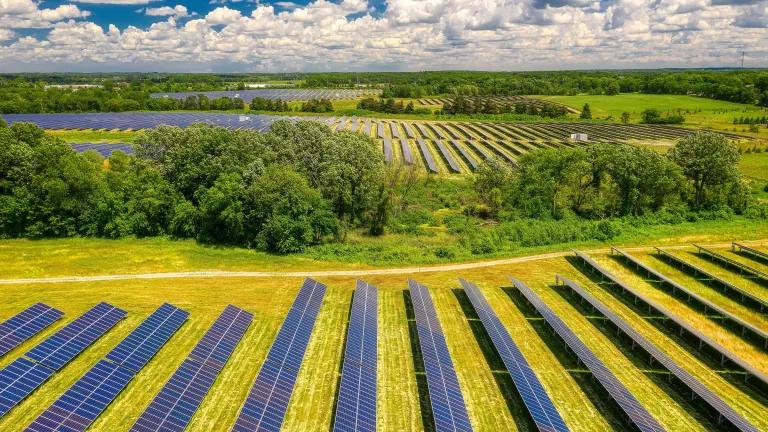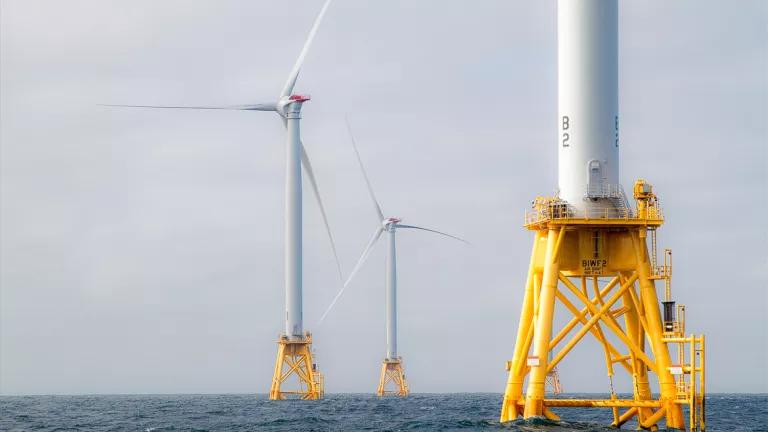AEO 2020: Renewables Clinch Power Sector

The U.S. Energy Information Administration’s new 2020 Annual Energy Outlook reassuringly projects that growth in America’s electricity generation will be met primarily by renewable sources, much like last year’s analysis. But a stubborn reliance on fossil fuels in other key parts of the economy like transportation and buildings reinforces the case for strong federal, state, and local policies to reduce carbon emissions in order to avoid catastrophic climate impacts. Without policies that promote both cleaner vehicles and efficient buildings, the United States remains dangerously off course.
The Annual Energy Outlook (AEO) is a projection of the future energy economy based on what’s true today. It relies on existing policies and current technology cost and performance projections to predict emissions and consumption trends in the energy sector. The AEO projections are significant as they are heavily relied upon as a key reference point for numerous energy and policy analyses.
The ongoing beacon of optimism: clean energy
Renewable energy continues its reign as the most economic choice to meet electricity demand, according to this year’s report. The Energy Information Administration (EIA) projects that renewable sources of electricity generation will overtake coal as the second-largest source of electricity as early as 2021, with continued steady growth driving renewables like wind and solar to surpass both gas and coal as the largest share of the electricity fuel mix by 2045, largely due to falling costs.
EIA projects renewables will grow from 17 percent of today’s generation to 24 percent in 2030 and 38 percent in 2050. But the report also includes a side-case that explores the possibility that renewables are even cheaper than expected, which is a scenario that many experts think is possible given the rapid pace of technology advancement. This low-cost scenario projects that by 2050 renewables could actually produce 50 percent of the electricity generated in the United States.
In reality, clean energy growth could outpace these projections. AEO has historically underestimated the future amount of renewable energy. The AEO reference case projections generally fall short of representing all current policies supporting renewable expansion and investment; for instance, AEO 2020 does not fully reflect the series of recent ambitious commitments by utilities and states to ramp up clean energy deployment and significantly reduce their carbon footprints.
Thanks to the plummeting costs of clean energy, as well as stronger state policies, EIA’s annual projections keep blowing through prior year estimates, with the crossover point between renewables and coal—where renewables overtake coal as a share of electricity generation–-getting markedly closer in recent years.

However, ramping up clean energy deployment will not be enough to decarbonize the power sector. EIA predicts emissions from generating electricity will steadily drop through 2030 but then roughly stagnate through 2050, despite rapid wind and solar growth. This is due to EIA's projections of coal power plant capacity staying online post-2030 and gas capacity rapidly expanding. Cleaning up the power sector requires that clean energy replaces fossil fuels, strengthening the case for state and federal policies like renewable and clean energy standards and limits on carbon emissions.
A big opportunity to put the United States on track
EIA forecasts economy-wide emissions reaching about 22 percent below 2005 levels in 2030, an improvement from the 18 percent prediction in last year’s report. This is mainly due to increased clean energy deployment. While steady progress has brought the United States closer to meeting established climate targets, being close is not enough. Recent estimates suggest that to meet the Paris Accord goal, the United States must reduce emissions about 3 percent annually over the next six years—much faster than the 0.9 percent average annual reduction achieved since 2005.

NRDC's modeling shows that the United States must achieve a 45 percent reduction in carbon dioxide (CO2) emissions by 2030 (compared to 2005) to avert 2 degrees of warming. The Intergovernmental Panel on Climate Change estimates that the world should achieve a 45 percent reduction in greenhouse gas emissions by 2030 (compared to 2010) to avert 1.5 degrees of warming.
Meanwhile, transportation and buildings are among the sectors thwarting emissions reductions. The EIA report projects that emissions in the buildings sector stagnate through 2050. This is due to a continued reliance on gas appliances like cookstoves and space and water heaters. However, we see a big opportunity to overturn this trend. Electric heat pumps are already more cost-effective than gas options for many people and recent building codes at the city and state level are helping consumers make the switch to all-electric, energy-efficient appliances. These building codes help consumers save money while planning for an affordable and equitable transition away from gas.
AEO also projects a similar trend in vehicle emissions. Absent policy, emissions from transportation will decline through 2027, when fuel efficiency standards are set to expire, and then rise through the 2030s and 2040s. However, there are a plethora of proven, smart policies that incentivize zero-emission vehicles and widespread electric vehicle (EV) charging infrastructure. And the good news is that EVs are already more cost-effective than gasoline vehicles in many applications. Entire coalitions of states are now committed to driving down transportation emissions by improving public transit and promoting EVs.
EIA’s latest forecast bolsters the case yet again for local, state, and federal policymakers to act swiftly and boldly to move the economy away from fossil fuels. The power sector has significantly reduced emissions over the last decade, and other sectors, like transportation and buildings, must and can follow suit. We have the solutions: Enacting policies that promote construction of net-zero emissions buildings, more electric vehicles, acceleration of clean energy resources, and retirement of dirty fossil plants. The 2020s will be the most critical years for climate action; there’s no time to waste.




